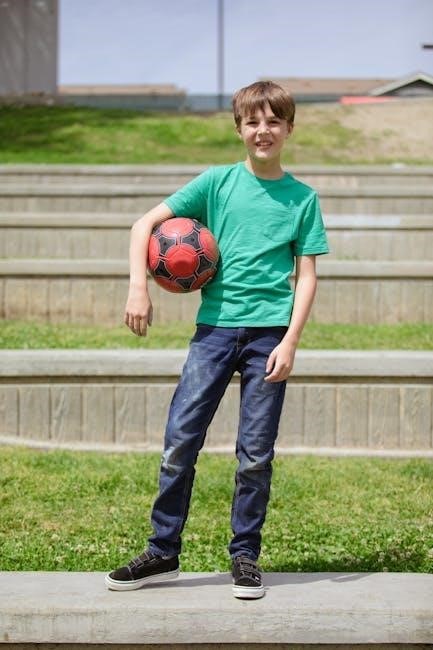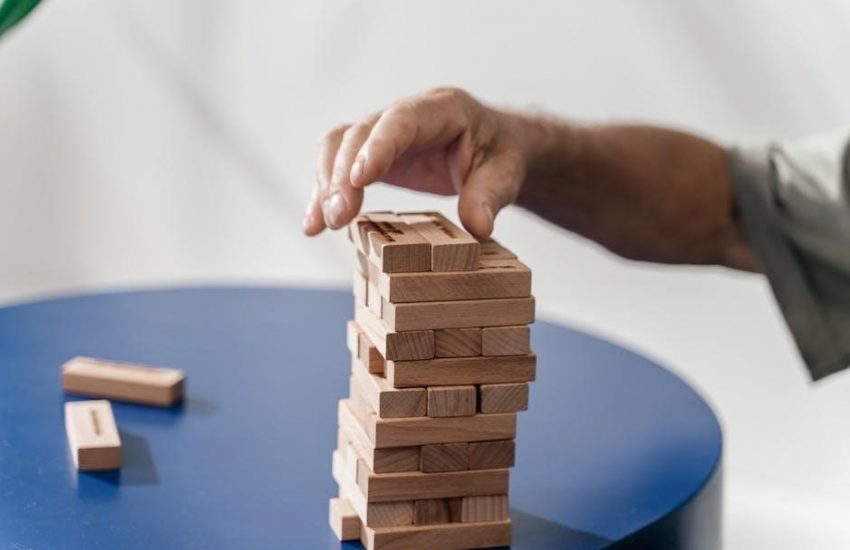youth soccer ball size guide
Choosing the right youth soccer ball size is crucial for skill development and safety. This guide helps parents and coaches select the perfect ball for their child’s age and skill level, ensuring optimal performance and enjoyment of the game. Learn about recommended sizes, materials, and drills to enhance every young player’s soccer experience.
Why Choosing the Right Soccer Ball Size Matters
Choosing the correct soccer ball size is essential for young players’ development and safety. A ball that is too large or heavy can hinder proper technique, discouraging skill mastery and increasing the risk of injury. Conversely, a ball that is too small may not challenge players appropriately as they grow. The right size ensures optimal control, making it easier for children to learn fundamental skills like dribbling, passing, and shooting. Properly sized balls also promote confidence and enjoyment of the game. By selecting a ball that matches their age and skill level, parents and coaches can help young athletes build a strong foundation for future success in soccer. This guide provides clear recommendations to make the selection process straightforward and effective.
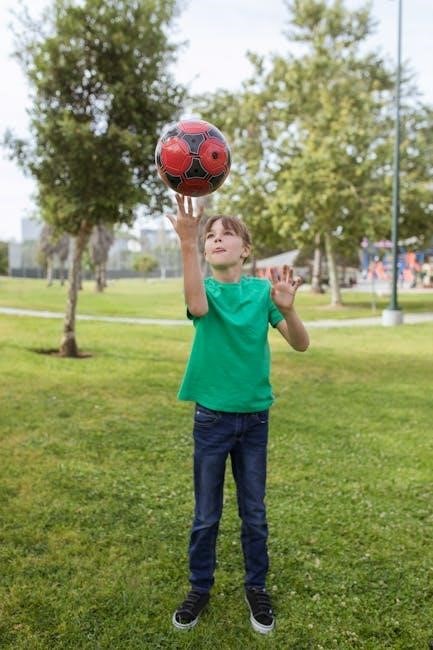
Overview of Youth Soccer Ball Sizes
Youth soccer balls are categorized into three main sizes: 3, 4, and 5. These sizes are designed to meet the needs of players at different developmental stages, ensuring safety and skill progression. Size 3 is the smallest, recommended for children aged 8 and under, with a circumference of 23-24 inches and a weight of 11-12 ounces. Size 4 is slightly larger, suitable for players aged 9-12, with a circumference of 25-26 inches and a weight of 13-15 ounces. Size 5 is the largest, used by players aged 13 and above, featuring a circumference of 27-28 inches and a weight of 14-15 ounces. Each size is tailored to provide the right balance of control and challenge, helping young players develop their skills effectively.
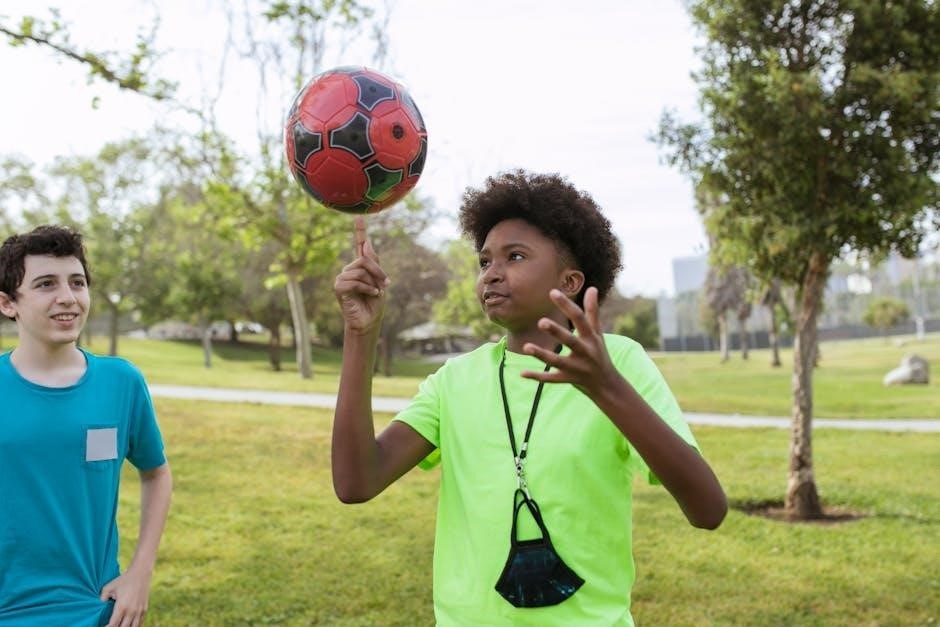
Soccer Ball Size Chart by Age Group
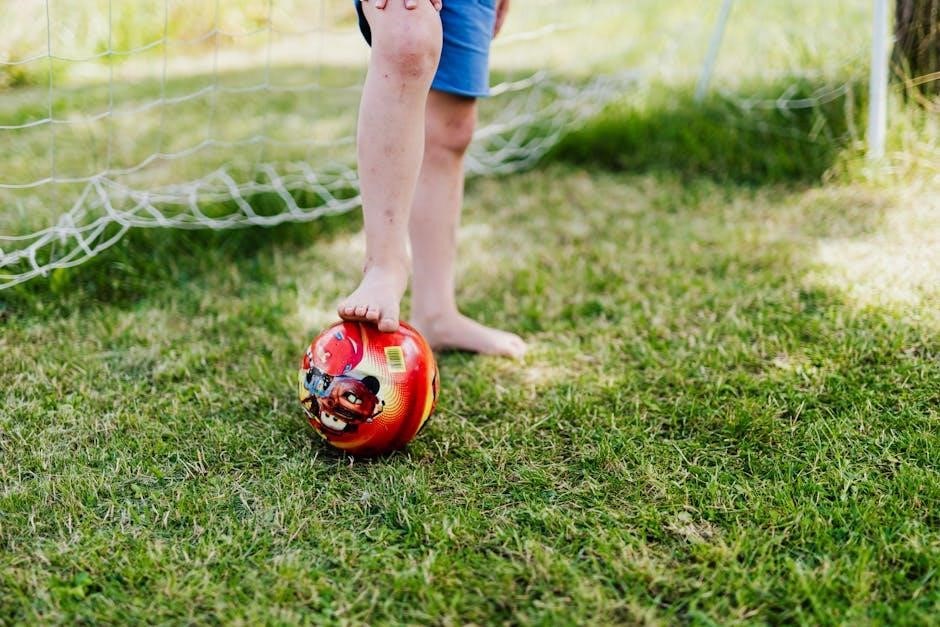
This chart outlines the recommended soccer ball sizes for youth players, ensuring proper fit and skill development. Size 3 (ages 8 and under), Size 4 (ages 9-12), and Size 5 (ages 13 and above) are standardized to meet the needs of growing players.
Size 3 Soccer Ball: Ages 8 and Under
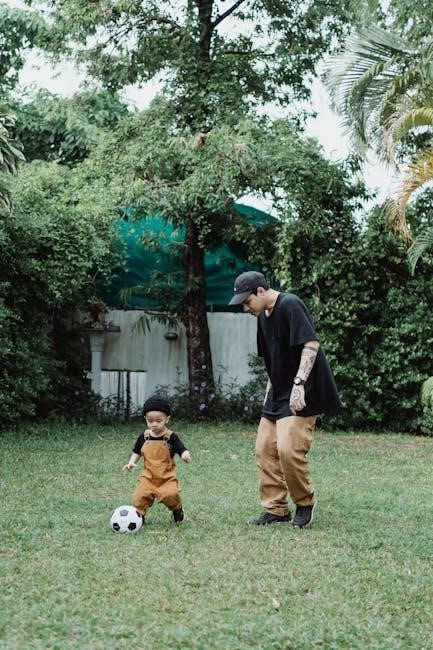
The Size 3 soccer ball is the smallest regulation size, designed for players aged 8 and under. It has a circumference of 23-24 inches and weighs approximately 11-12 ounces. This smaller, lighter ball is ideal for young players, making it easier to handle and control. The reduced size and weight allow children to develop fundamental skills like dribbling, passing, and shooting without struggling with a ball that’s too large or heavy. Using the correct size ball at this age is essential for building confidence and technique, ensuring a strong foundation for future growth in the sport. Coaches and parents often recommend this size for training sessions and games, as it aligns with the physical abilities of younger players.
Size 4 Soccer Ball: Ages 9-12
The Size 4 soccer ball is designed for players aged 9-12, offering a balance between size and weight that supports skill development. It has a circumference of 25-26 inches and weighs approximately 13-14 ounces. This size is larger than the Size 3 ball, providing a gradual transition for growing players. The slightly increased weight and size help improve control and technique, making it ideal for this age group. Coaches and parents often recommend this size for training sessions and competitive games, as it aligns with the physical strength and skill level of pre-teen players. Using the correct size ball at this stage is crucial for enhancing dribbling, passing, and shooting abilities, ensuring young players continue to build confidence and mastery of the game.
Size 5 Soccer Ball: Ages 13 and Above
The Size 5 soccer ball is the largest regulation size, designed for players aged 13 and above, including adults. It has a circumference of 27-28 inches and weighs approximately 14-15 ounces. This size is ideal for advanced players, as it requires more strength and skill to control. The larger and heavier design prepares players for competitive and professional-level games. Coaches recommend this size for training sessions and matches involving teenagers and adults, as it aligns with their physical strength and advanced techniques. Using a Size 5 ball at this stage helps refine dribbling, passing, and shooting skills, ensuring players can handle the demands of high-level play. It is the standard size used in professional leagues and tournaments worldwide.
Understanding Soccer Ball Specifications
Soccer ball specifications include standardized circumference, weight, and material requirements. Size 3, 4, and 5 balls vary in measurements, ensuring consistency and safety for players of all ages.
Circumference and Weight Requirements
Soccer ball specifications are standardized to ensure consistency and safety. For youth players, Size 3 balls have a circumference of 23-24 inches and weigh 11-12 ounces, making them ideal for ages 8 and under. Size 4 balls, recommended for ages 9-12, measure 25-26 inches in circumference and weigh 13-15 ounces. Size 5 balls, used for ages 13 and above, have a circumference of 27-28 inches and weigh 14-15 ounces. These measurements ensure the ball is appropriate for the player’s age and skill level, promoting proper technique and safety. Adhering to these standards helps young players develop skills effectively and enjoy the game fully.
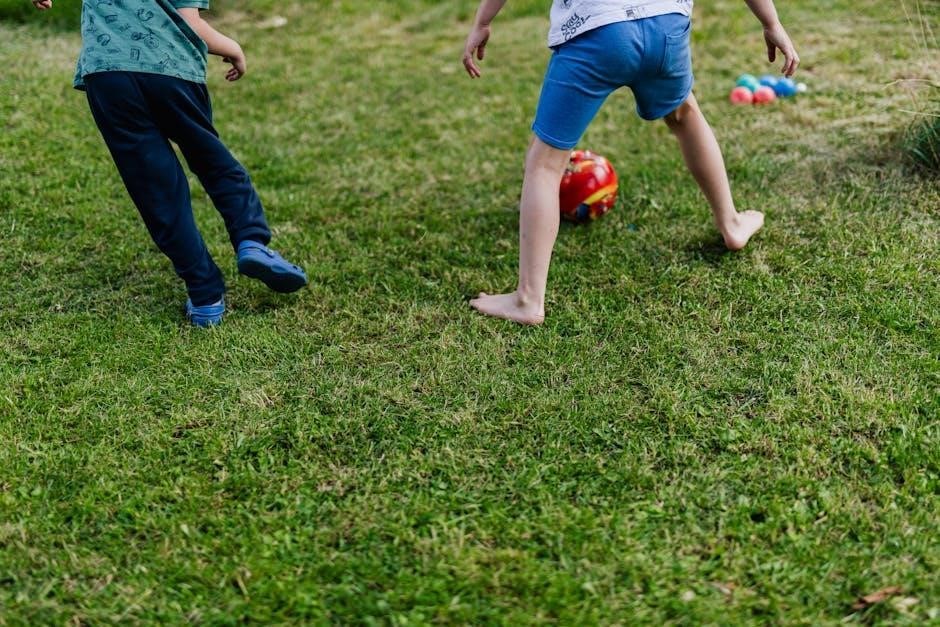
Material Differences: Leather, Synthetic, and Foam
Soccer balls are made from various materials, each offering unique benefits. Leather balls are traditional and provide a soft touch, but they are heavier and require maintenance. Synthetic balls are durable, water-resistant, and lightweight, making them ideal for youth players. Foam balls are soft and lightweight, perfect for young children learning basic skills. The choice of material depends on the player’s age, skill level, and playing conditions. Synthetic and foam balls are most common in youth soccer due to their safety and durability. Leather balls are less common but preferred by some for their classic feel. Understanding material differences helps parents and coaches select the best ball for their child’s needs, ensuring comfort, safety, and performance.

Benefits of Using the Correct Ball Size
Using the correct ball size enhances skill development, safety, and confidence. It ensures proper technique, reduces injury risk, and allows young players to control and maneuver the ball effectively.
Improved Skill Development
Using the correct ball size significantly enhances skill development in young players. A ball that is appropriately sized for a child’s age and skill level allows for better control and maneuverability. This makes it easier to master fundamental skills such as dribbling, passing, and shooting. When the ball is neither too heavy nor too large, players can focus on proper technique, leading to improved coordination and precision. Additionally, the right size ball encourages confidence and creativity on the field, as players can execute moves more effectively. Over time, this leads to overall better performance and a stronger foundation for advanced play. Proper ball size is essential for fostering growth and excellence in youth soccer.
Enhanced Safety for Young Players
Using the correct ball size enhances safety for young players by reducing the risk of injury. A ball that is too large or heavy can be difficult to control, potentially leading to accidents or strain. Properly sized balls are designed to match the physical abilities of children, ensuring they can handle the ball safely. This reduces the likelihood of head injuries from misplaced headers or collisions caused by oversized balls. Additionally, the right size ball promotes better technique, as players are not overexerting themselves to manage a ball that is too big. This focus on safety allows young athletes to enjoy the game while developing their skills confidently. Proper ball size is a critical factor in creating a secure and enjoyable playing environment for youth soccer players.
Boosting Confidence and Control
Using the correct ball size plays a significant role in boosting a young player’s confidence and control. A ball that is appropriately sized for a child’s age and skill level is easier to handle, allowing them to perform skills like dribbling, passing, and shooting with greater precision; When the ball is too large or heavy, it can be discouraging and make learning difficult. The right size ensures that players can manage the ball effectively, fostering a sense of accomplishment and confidence. This, in turn, encourages them to take on new challenges and develop their skills further. By providing a ball that matches their abilities, young players can build a strong foundation and enjoy the game more fully. Proper ball size is essential for helping youth soccer players feel capable and confident on the field.
How to Choose the Right Ball for Your Child
Selecting the right soccer ball for your child involves considering their age, skill level, and consulting official size charts. Practical tips help parents and coaches make informed decisions.
Age and Skill Level Considerations
When selecting a soccer ball, consider your child’s age and skill level. Younger players (ages 8 and under) benefit from a Size 3 ball, which is smaller and lighter, making it easier to control. As players grow older and their skills improve, they progress to larger sizes. For ages 9-12, a Size 4 ball is ideal, offering a balance between control and power. Players aged 13 and above use a Size 5 ball, the same as professionals, to develop advanced techniques. Always consult official size charts and consider your child’s comfort and ability to ensure the best fit for their development and safety.
Practical Tips for Parents and Coaches
Helping your child choose the right soccer ball starts with understanding their needs. Always refer to the official soccer ball size chart by age to ensure proper fit. For younger players, prioritize lighter and smaller balls to make handling easier. As skills improve, gradually move to larger sizes. Consider the ball’s material—synthetic or foam balls are durable and suitable for training, while leather balls are ideal for advanced play. Encourage your child to test the ball’s bounce and feel to ensure comfort. Coaches should incorporate drills tailored to each ball size to maximize skill development. By focusing on the right size and quality, you can help your child enjoy the game while improving their performance.
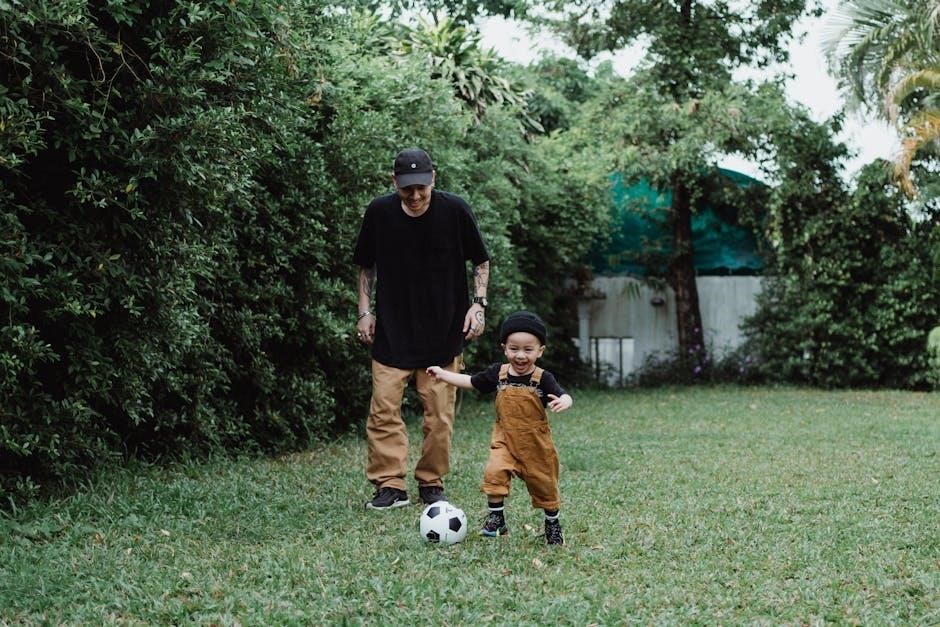
Training Drills for Each Ball Size
Drills are tailored to each ball size to enhance skill development. Size 3 focuses on basic dribbling and control, while Size 4 emphasizes passing accuracy. Size 5 builds fitness and game scenarios, ensuring players master techniques specific to their level.
Drills for Size 3 Balls
Drills for Size 3 balls focus on developing fundamental skills in young players. Start with basic dribbling exercises like “Dribble Through Cones,” where players weave through cones to improve control. “Passing Pairs” helps build accuracy and teamwork, as players pass the ball back and forth. Shooting drills, such as “Goal Target Practice,” encourage precision and power. Incorporate games like “Red Light, Green Light” to make learning fun. These drills are designed to enhance coordination, balance, and ball control, preparing players for more advanced techniques as they grow. Keep sessions engaging and age-appropriate to foster a love for the game while building essential soccer skills.
Drills for Size 4 Balls
Drills for Size 4 balls are designed to refine skills in players aged 9-12. Begin with “Dribble Tag,” where players practice ball control while evading others. “Passing Relays” involve teams passing the ball through cones to a teammate, emphasizing accuracy and speed. Shooting drills like “Breakaway Challenge” help players practice scoring under pressure. Incorporate small-sided games, such as 3v3 or 4v4, to apply skills in game-like situations. Agility exercises, like zigzag runs with the ball, improve footwork and balance. These drills build on foundational skills, fostering confidence and teamwork while preparing players for more competitive play. Keep the focus on fun and improvement to maintain engagement and motivation.
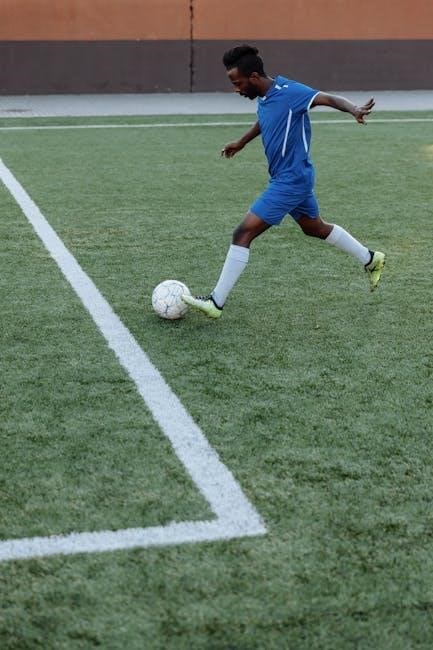
Drills for Size 5 Balls
Drills for Size 5 balls are tailored for players aged 13 and above, focusing on advanced skill refinement. Begin with “Ball Control Ladders,” where players weave through cones and ladders, enhancing agility and precision. “Shooting Accuracy” drills involve striking the ball from various distances and angles, targeting specific areas of the goal. “Passing Puzzles” challenge players to deliver precise long and short passes to teammates. Incorporate “Game Scenario Simulations,” where players practice decision-making in high-pressure situations. Advanced dribbling drills, such as “Beat the Defender,” help refine 1v1 skills. These exercises prepare players for competitive play, emphasizing strategy, teamwork, and technical mastery. They are designed to challenge older players and elevate their performance to the next level.
Selecting the right youth soccer ball size is essential for skill development, safety, and confidence. By following this guide, parents and coaches can ensure young players enjoy the game while improving their abilities. Proper ball size fosters better technique, control, and overall performance, helping players reach their full potential. Encourage a love for soccer with the right tools and training, and watch your child thrive on the field.
Final Thoughts on Selecting the Right Youth Soccer Ball
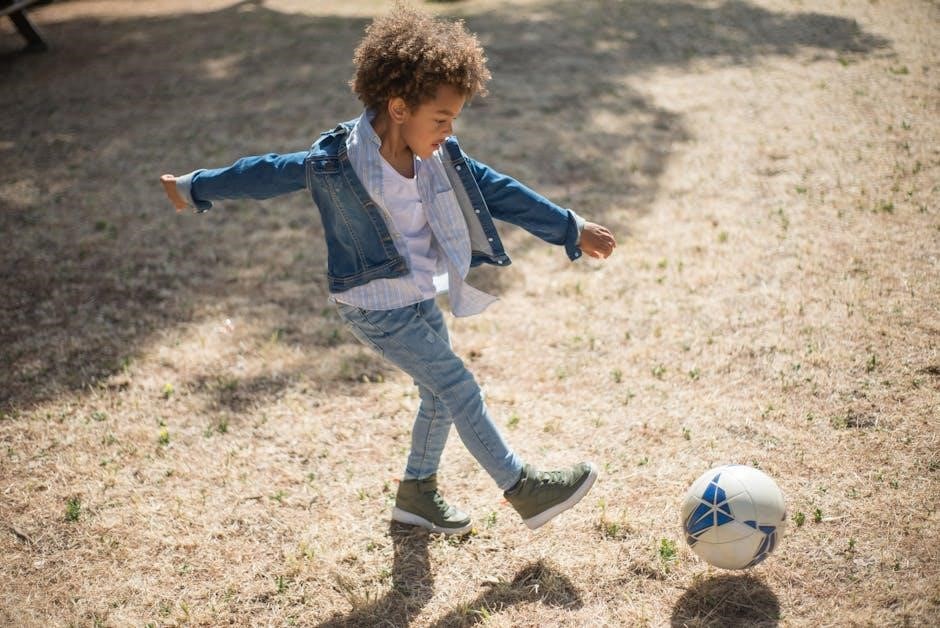
Selecting the right youth soccer ball size is a decision that impacts skill development, safety, and overall enjoyment of the game. By understanding the recommended sizes for each age group, parents and coaches can provide young players with the tools they need to succeed. A ball that is appropriately sized ensures proper technique, better control, and reduced risk of injury. Additionally, the right size fosters confidence, allowing players to focus on improving their abilities. Whether your child is just starting out or advancing in their soccer journey, investing in the correct ball size is a simple yet effective way to support their growth and passion for the sport.
